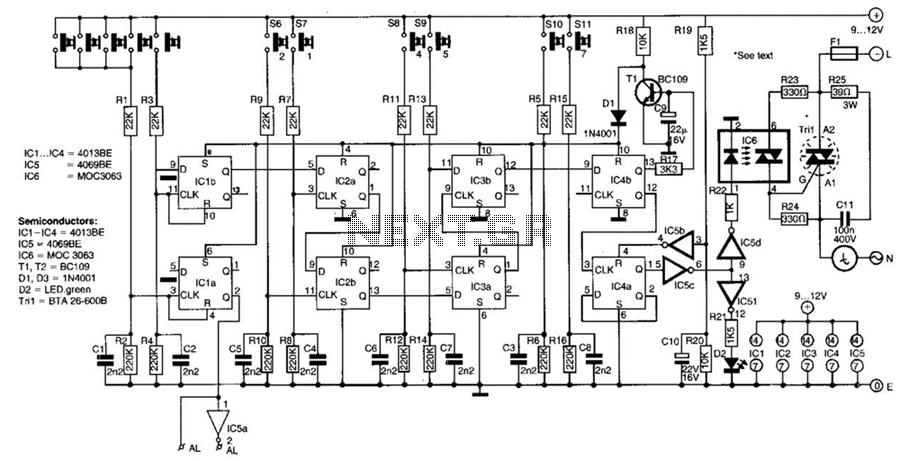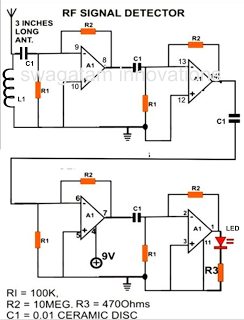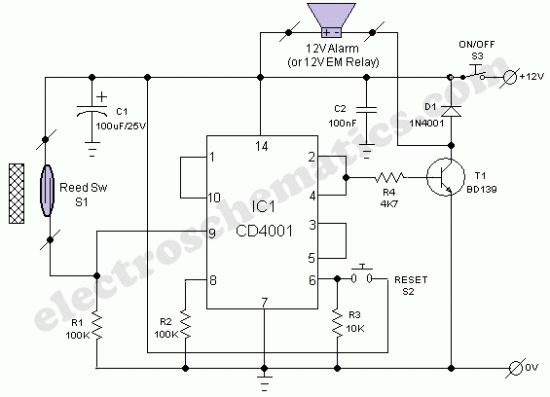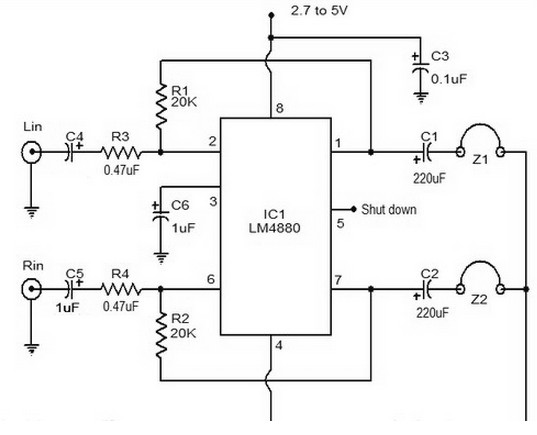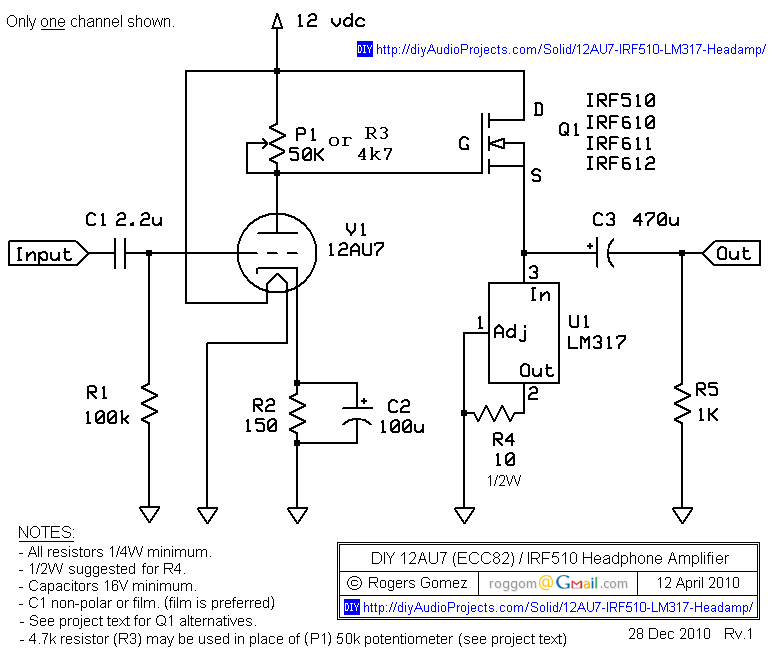
One transistor code lock
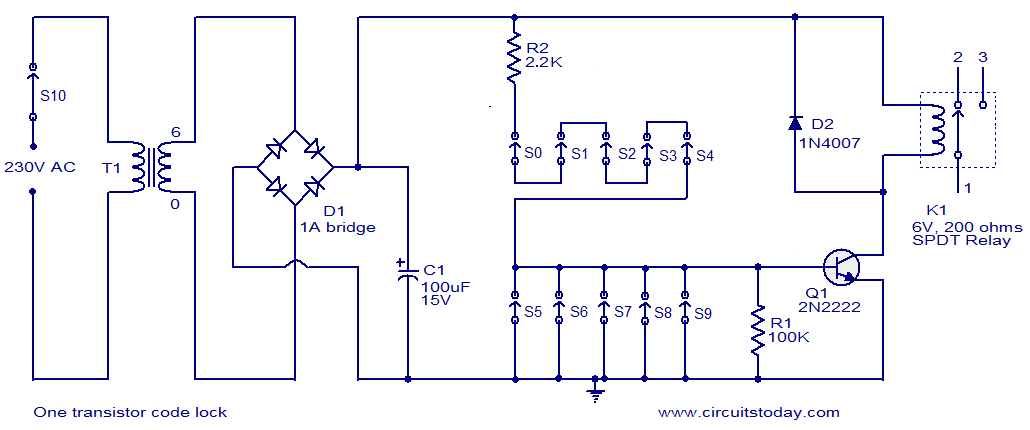
This is a simple electronic code lock circuit that can be easily constructed. The circuit consists of one transistor, a relay, and several passive components. Its simplicity does not compromise performance, and it functions effectively. The circuit operates as a basic transistor switch with a relay connected to its collector as the load. Five switches (S0 to S4) are arranged in series with a current-limiting resistor (R2) connected to the base of the transistor and the positive supply rail. Another five switches (S5 to S9) are arranged in parallel and connected to the base of the transistor and ground. The transistor (Q1) will turn ON and activate the relay only when all switches S0 to S4 are ON and switches S5 to S9 are OFF. It is recommended to arrange these switches in a randomized order on the panel. The relay will engage only if the combination of switches S0 to S9 is either OFF or ON in the correct sequence. The device controlled by the lock circuit can be connected through the relay terminals. The power supply section of the circuit is formed by transformer (T1), bridge rectifier (D1), and capacitor (C1). Diode (D2) functions as a freewheeling diode, while resistor (R1) ensures that transistor (Q1) remains OFF when there is no connection between its base and the positive supply rail.
The electronic code lock circuit operates on the principle of using a transistor as a switch, which is controlled by the state of multiple input switches. The arrangement of the switches is crucial for ensuring that the correct combination is required to activate the relay. The series connection of switches S0 to S4 allows for a high signal at the base of the transistor only when all these switches are closed (ON). Conversely, the parallel configuration of switches S5 to S9 ensures that the transistor remains OFF when any of these switches are closed (ON).
The relay serves as the output mechanism, allowing for the control of a larger load, such as a door lock or an alarm system, based on the state of the transistor. The power supply section, comprising the transformer (T1), bridge rectifier (D1), and capacitor (C1), converts the AC voltage from the mains to a suitable DC voltage required for the operation of the circuit. The freewheeling diode (D2) protects the transistor from voltage spikes generated when the relay coil is de-energized, which could otherwise cause damage to the transistor.
Resistor (R1) plays a vital role in ensuring that the transistor does not inadvertently turn ON due to noise or floating voltages at the base when the switches are not engaged. The design allows for flexibility in the arrangement of the switches, enabling customization of the lock code while maintaining a straightforward implementation. This circuit is ideal for applications requiring simple access control mechanisms, providing a reliable and efficient solution for electronic locking systems.This is of course the simplest electronic code lock circuit one can make. The circuit uses one transistor, a relay and few passive components. The simplicity does not have any influence on the performance and this circuit works really fine. The circuit is nothing but a simple transistor switch with a relay at its collector as load. Five switches ( S0 to S4) arranged in series with the current limiting resistor R2 is connected across the base of the transistor and positive supply rail. Another five switches (S5 to S9) arranged in parallel is connected across the base of the transistor and ground.
The transistor Q1 will be ON and relay will be activated only if all the switches S0 to S4 are ON and S5 to S9 are OFF. Arrange these switches in a shuffled manner on the panel and that it. The relay will be ON only if the switches S0 to S9 are either OFF or ON in the correct combination. The device to be controlled using the lock circuit can be connected through the relay terminals. Transformer T1, bridge D1, capacitor C1 forms the power supply section of the circuit. Diode D2 is a freewheeling diode. Resistor R1 ensures that the transistor Q1 is OFF when there is no connection between its base and positive supply rail.
🔗 External reference
The electronic code lock circuit operates on the principle of using a transistor as a switch, which is controlled by the state of multiple input switches. The arrangement of the switches is crucial for ensuring that the correct combination is required to activate the relay. The series connection of switches S0 to S4 allows for a high signal at the base of the transistor only when all these switches are closed (ON). Conversely, the parallel configuration of switches S5 to S9 ensures that the transistor remains OFF when any of these switches are closed (ON).
The relay serves as the output mechanism, allowing for the control of a larger load, such as a door lock or an alarm system, based on the state of the transistor. The power supply section, comprising the transformer (T1), bridge rectifier (D1), and capacitor (C1), converts the AC voltage from the mains to a suitable DC voltage required for the operation of the circuit. The freewheeling diode (D2) protects the transistor from voltage spikes generated when the relay coil is de-energized, which could otherwise cause damage to the transistor.
Resistor (R1) plays a vital role in ensuring that the transistor does not inadvertently turn ON due to noise or floating voltages at the base when the switches are not engaged. The design allows for flexibility in the arrangement of the switches, enabling customization of the lock code while maintaining a straightforward implementation. This circuit is ideal for applications requiring simple access control mechanisms, providing a reliable and efficient solution for electronic locking systems.This is of course the simplest electronic code lock circuit one can make. The circuit uses one transistor, a relay and few passive components. The simplicity does not have any influence on the performance and this circuit works really fine. The circuit is nothing but a simple transistor switch with a relay at its collector as load. Five switches ( S0 to S4) arranged in series with the current limiting resistor R2 is connected across the base of the transistor and positive supply rail. Another five switches (S5 to S9) arranged in parallel is connected across the base of the transistor and ground.
The transistor Q1 will be ON and relay will be activated only if all the switches S0 to S4 are ON and S5 to S9 are OFF. Arrange these switches in a shuffled manner on the panel and that it. The relay will be ON only if the switches S0 to S9 are either OFF or ON in the correct combination. The device to be controlled using the lock circuit can be connected through the relay terminals. Transformer T1, bridge D1, capacitor C1 forms the power supply section of the circuit. Diode D2 is a freewheeling diode. Resistor R1 ensures that the transistor Q1 is OFF when there is no connection between its base and positive supply rail.
🔗 External reference
